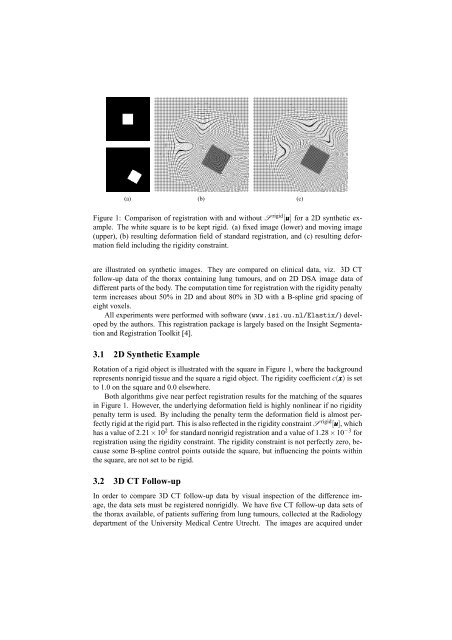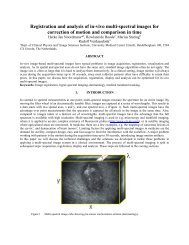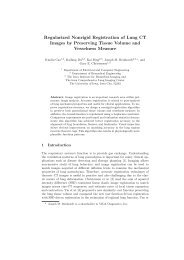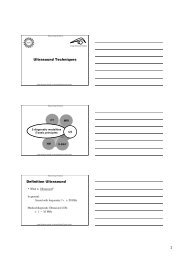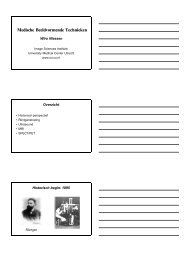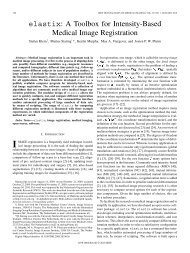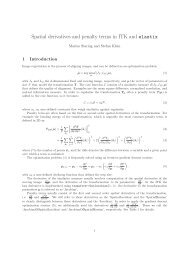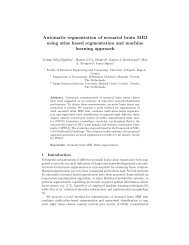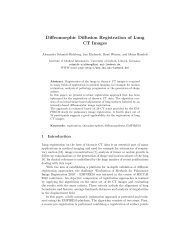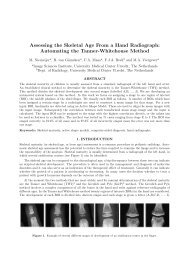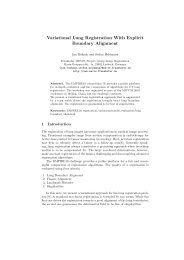Evaluation of a Rigidity Penalty Term for Nonrigid Registration - elastix
Evaluation of a Rigidity Penalty Term for Nonrigid Registration - elastix
Evaluation of a Rigidity Penalty Term for Nonrigid Registration - elastix
You also want an ePaper? Increase the reach of your titles
YUMPU automatically turns print PDFs into web optimized ePapers that Google loves.
(a) (b) (c)<br />
Figure 1: Comparison <strong>of</strong> registration with and without S rigid [u] <strong>for</strong> a 2D synthetic example.<br />
The white square is to be kept rigid. (a) fixed image (lower) and moving image<br />
(upper), (b) resulting de<strong>for</strong>mation field <strong>of</strong> standard registration, and (c) resulting de<strong>for</strong>mation<br />
field including the rigidity constraint.<br />
are illustrated on synthetic images. They are compared on clinical data, viz. 3D CT<br />
follow-up data <strong>of</strong> the thorax containing lung tumours, and on 2D DSA image data <strong>of</strong><br />
different parts <strong>of</strong> the body. The computation time <strong>for</strong> registration with the rigidity penalty<br />
term increases about 50% in 2D and about 80% in 3D with a B-spline grid spacing <strong>of</strong><br />
eight voxels.<br />
All experiments were per<strong>for</strong>med with s<strong>of</strong>tware (www.isi.uu.nl/Elastix/) developed<br />
by the authors. This registration package is largely based on the Insight Segmentation<br />
and <strong>Registration</strong> Toolkit [4].<br />
3.1 2D Synthetic Example<br />
Rotation <strong>of</strong> a rigid object is illustrated with the square in Figure 1, where the background<br />
represents nonrigid tissue and the square a rigid object. The rigidity coefficient c(x) is set<br />
to 1.0 on the square and 0.0 elsewhere.<br />
Both algorithms give near perfect registration results <strong>for</strong> the matching <strong>of</strong> the squares<br />
in Figure 1. However, the underlying de<strong>for</strong>mation field is highly nonlinear if no rigidity<br />
penalty term is used. By including the penalty term the de<strong>for</strong>mation field is almost perfectly<br />
rigid at the rigid part. This is also reflected in the rigidity constraint S rigid [u], which<br />
has a value <strong>of</strong> 2.21×10 2 <strong>for</strong> standard nonrigid registration and a value <strong>of</strong> 1.28×10 −3 <strong>for</strong><br />
registration using the rigidity constraint. The rigidity constraint is not perfectly zero, because<br />
some B-spline control points outside the square, but influencing the points within<br />
the square, are not set to be rigid.<br />
3.2 3D CT Follow-up<br />
In order to compare 3D CT follow-up data by visual inspection <strong>of</strong> the difference image,<br />
the data sets must be registered nonrigidly. We have five CT follow-up data sets <strong>of</strong><br />
the thorax available, <strong>of</strong> patients suffering from lung tumours, collected at the Radiology<br />
department <strong>of</strong> the University Medical Centre Utrecht. The images are acquired under


